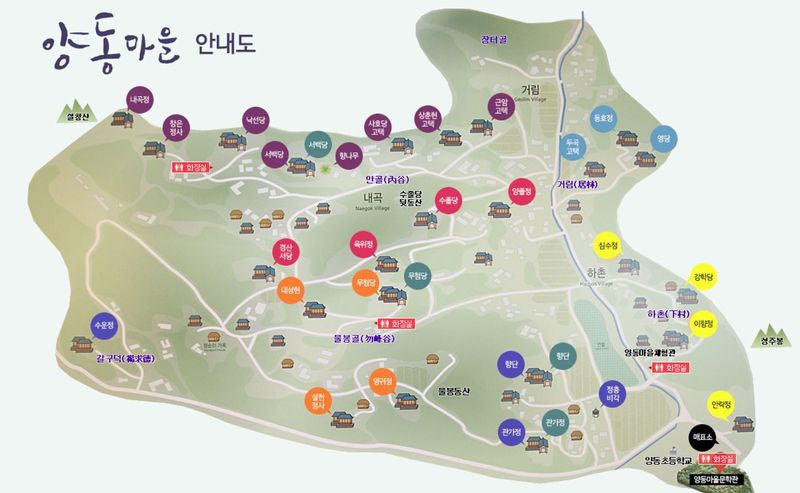경주 양동마을
| 경주 양동마을 Yangdong Village, Gyeongju |
|
| 대표명칭 | 경주 양동마을 |
|---|---|
| 영문명칭 | Yangdong Village, Gyeongju |
| 한자 | 慶州 良洞마을 |
| 주소 | 경상북도 경주시 강동면 양동마을길 134 |
| 지정(등록) 종목 | 국가민속문화재 제189호 |
| 지정(등록)일 | 1984년 12월 24일 |
| 분류 | 유적건조물/주거생활/주거건축/마을 |
| 시대 | 조선시대 |
| 수량/면적 | 474필지/969,115㎡ |
| 웹사이트 | 문화재청 국가문화유산포털 |
|
|
|
해설문
국문
이 마을은 조선시대 전통문화와 자연을 고스란히 간직하고 있는 한국 최대 규모의 전통마을이다. 경주손씨와 여주이씨를 중심으로 형성된 씨족마을로 500년이 넘는 전통을 가지고 있다. 양민공 손소(襄敏公 孫昭, 1433~1484)가 풍덕류씨와 혼인하여 처가가 있는 이곳에 들어온 것을 계기로 경주손씨가 양동마을에 뿌리를 내리게 되었다. 여주이씨는 찬성공 이번(贊成公 李蕃, 1463~1500)이 손소의 사위가 되면서 이 마을에 자리를 잡게 되었다. 조선 전기에는 이처럼 혼인한 신랑이 처가를 따라가서 사는 풍습이 있었다. 그동안 두 집안에서는 우재 손중돈(愚齋 孫仲暾, 1463~1529)과 회재 이언적(晦齋 李彦迪, 1491~1553) 등 많은 유학자를 배출하였다.
마을 앞으로는 안강평야가 넓게 펼쳐져 있으며, 설창산 산줄기에 마을이 들어선 모양새가 독특하고 아름답다. 산에서 뻗어내린 네 줄기의 능선과 골짜기를 따라 150여 채의 옛집들이 굽이굽이 들어서 있는데, 이 중에서는 임진왜란(壬辰倭亂, 1592~1598) 이전에 지어진 기와집이 네 채나 남아 있어 눈여겨 볼만하다. 집들은 대개 ‘ㅁ’자 모양인데, 이는 조선 중기 영남지방의 일반적인 가옥 형태이다. 다양한 가옥의 조화는 우리나라 전통역사마을의 생활모습을 잘 보여주고 있다.
마을 주변의 산, 들판, 강 등 아름다운 자연환경과 함께 ‘하늘의 별처럼 늘어서 있는 마을의 고택(星羅古宅)’은 진풍경이다. 양동마을은 전체가 국가민속문화재(1984), 세계문화유산(2010), 형산강팔경(2016)으로 선정되어 보전되고 있다.
영문
Yangdong Village is Korea’s largest clan village. It is comprised of over 150 buildings built in the traditional Korean style, including houses, shrines, pavilions, study halls, and more. It was established in the late 15th century by the Gyeongju Son Clan and the Yeoju Yi Clan. The origin story and layout of Yangdong Village are representative of Korean clan villages. The village residents have continued to preserve the original spiritual legacy of the village by performing the traditional rituals and customs of upper-class families of the Joseon period until today. For these reasons, Yangdong Village was inscribed on the UNESCO World Heritage List in 2010.
In the Joseon period (1392-1910), a clan was established by a patriarch and was comprised of its descendants. The primary lineage of first-born male descendants, called the "head family," would live in the clan village, which would serve as a home base for the clan's Confucian education and ancestral rituals. The head families of Yangdong Village were established when Son So (1433-1484) of the Gyeongju Son Clan moved to this area upon his marriage to a woman from the Pungdeok Ryu Clan who lived in the village. Then, when one of Son So's daughters married Yi Beon (1463-1500) from the Yeoju Yi Clan, Yi Beon also moved into his new wife's village. The sons of these founding patriarchs went on to achieve great accomplishments. Son Jung-don (1463-1529), a son of Son So, was a highly esteemed civil official, and his nephew Yi Eon-jeok (1491-1553), a son of Yi Beon, was one of the most prominent Confucian scholars of the Joseon period. The head families of these two lineages continue to live in Yangdong Village to this day, maintaining their family traditions.
Yangdong Village is located with a mountain to the north and a river to the south. To the west of the village is a wide, open field, which served as the economic foundation of the village. The composition of Yangdong Village is typical of Korean clan villages, with the houses of low-class servants at the entrance to the village near the river and farm fields, and the houses of the upper-class clan members in the back of the village, protected by the mountain. The style of buildings in Yangdong Village are typical of the Gyeongsang-do region, with elevated stone foundations and square layouts with a courtyard.
Other historic places nearby Yangdong Village include Yi Eon-jeok’s house called Dongnakdang, and two Confucian academies, Oksanseowon and Donggangseowon, which honor Yi Eon-jeok and Son Jung-don, respectively.
영문 해설 내용
양동마을은 한국에서 가장 큰 씨족마을이다. 이 마을은 가옥, 사당, 누정, 강당 등 한국 전통 양식으로 지어진 150개 이상의 건물로 구성되어 있다. 15세기 후반 경주손씨와 여주손씨에 의해 형성되었으며, 마을의 연원과 배치는 한국 씨족마을의 전형적인 사례를 보여준다. 오늘날까지도 마을 주민들은 조선시대 상류층 가정의 의례와 풍습을 유지하며 마을의 유산을 지켜왔다. 이러한 이유로 양동마을은 2010년 유네스코 세계유산으로 등재되었다.
조선시대의 문중은 부계혈통에 의해 세워지고 그 후손들에 의해 유지되었다. 장자에 의해 이어지는 '종가'는 씨족마을에 거주하며 문중의 교육과 제사를 위한 본거지 역할을 하였다. 양동마을에서는 경주손씨의 손소(1433-1484)가 이 마을에 살던 풍덕류씨의 딸과 혼인하면서 양동마을에 뿌리를 내리게 되었다. 손소의 딸이 여주이씨의 이번(1463-1529)과 혼인하면서 여주이씨도 이 마을에 자리를 잡았다. 이후 두 집안의 후손들이 큰 업적을 남겼다. 손소의 아들인 손중돈(1463-1529)은 존경받는 문신이었고, 이번의 아들인 이언적(1491-1553)은 조선시대 최고의 유학자 중 하나로 손꼽힌다. 이 두 가문의 종가는 오늘날까지 양동마을에 계속 살면서 가문의 전통을 유지하고 있다.
양동마을은 북쪽에 산과 남쪽에 강을 두고 있다. 서쪽에는 마을의 경제적 토대가 된 넓은 평야가 있다. 양동마을은 마을 입구의 강과 농경지 주위에 하인들의 집이 있고, 양반들의 가옥은 산으로 둘러쌓인 마을 뒤편에 위치하여, 한국 씨족마을의 전형적인 구조를 보여준다. 양동마을의 건물들은 대개 높은 기반 위에 세워진 'ㅁ'자형이며, 이는 경상도 지역의 일반적인 형태이다.
양동마을 인근의 다른 유적으로는 이언적이 살던 독락당과 이언적과 손중돈을 기리는 옥산서원과 동강서원이 있다.
이야기 관계망
갤러리
